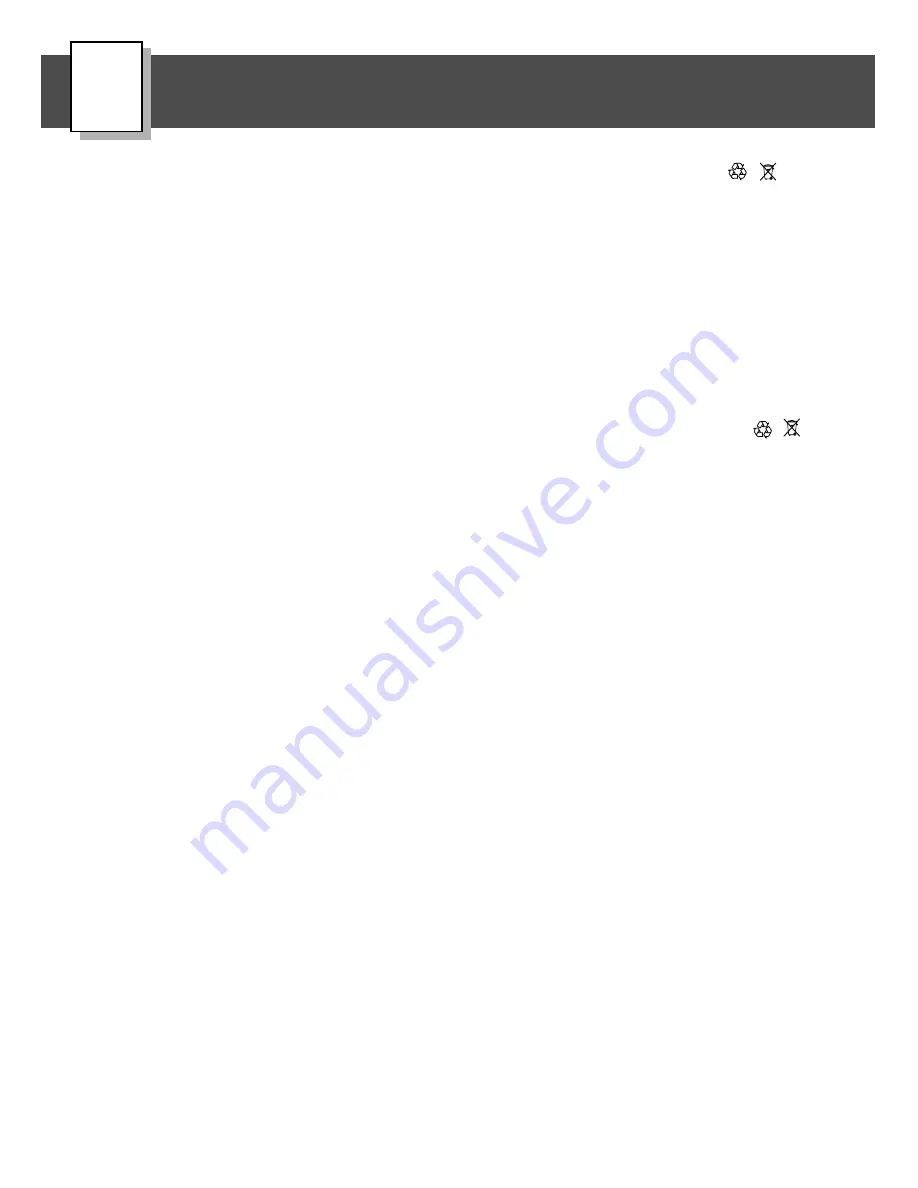
18
S
Mantenimiento
Si ocurre un derrame de la batería,
evitar
el contacto con el ácido que se derramó y
colocar la batería dañada en una bolsa de
plástico. Consultar la información de abajo
sobre la eliminación de la batería.
Si el ácido entra en contacto con la
piel o los ojos,
enjuagar con agua fría
durante por lo menos 15 minutos y llamar
a un médico.
Si se ingiere el ácido,
beber de inmediato
agua, leche de magnesia o claras de
huevo. Nunca tomar vomitivos ni provocar
vómito. Llamar a un médico.
• Cargar una batería nueva durante por lo
menos 18 horas antes del primer uso.
Nunca cargar la batería por más de 30
horas. Sobrecargar la batería o no cargarla
lo suficiente puede reducir la duración
de la batería y reducir el rendimiento
del vehículo.
• Después de la primera carga, cargar la
batería durante por lo menos 14 horas
después de cada uso. Nunca cargar la
batería por más de 30 horas. Cargar la
batería después de cada uso, sin importar
cuánto se haya usado el vehículo.
• La batería debe estar en posición vertical
mientras se carga.
• No permitir que la batería se desgaste
completamente antes de volver a cargarla.
• Cargar la batería antes de almacenar
el vehículo.
• Cargar la batería por lo menos una vez
al mes, incluso si no se ha utilizado
el vehículo.
• Si deja la batería descargada, ésta
se arruinará.
• Siempre sacar la batería gastada del
vehículo. Un derrame y corrosión de la
batería puede dañar el vehículo.
• No almacenar las baterías en temperaturas
sobre 24°C o debajo de -23°C.
• Evitar que la batería se mueva dentro
del compartimento.
Siempre usar el
retenedor de la batería para asegurarla
en posición.
• Examinar la batería, el cargador y el
conector, cada vez que se cargue la
batería, para verificar que no estén
gastados ni dañados. Si detecta algún
daño, no utilizar la batería ni el cargador
sino hasta que haya sido repuesta la
parte dañada.
e
Disposal
• Your Power Wheels
®
battery is a sealed
lead-acid battery. It must be recycled or
disposed of in an environmentally
sound manner.
• Do not dispose of a lead-acid battery in a
fire. The battery may explode or leak.
• Do not dispose of a lead-acid battery in your
regular, household trash. The incineration,
landfilling or mixing of sealed lead-acid
batteries with household trash is prohibited
by law in most areas.
• Return exhausted batteries to an approved
lead-acid battery recycler. Contact your
local waste management officials for other
information regarding the environmentally
sound collection, recycling and disposal of
lead-acid batteries.
S
Eliminación
• La batería Power Wheels es una batería
de ácido plomo precintada. Debe ser
reciclada o eliminada de manera que no
afecte al medio ambiente.
• No tirar la batería de ácido plomo en fuego.
La batería puede explotar o derramarse.
• No tirar la batería de ácido plomo en la
basura en su casa. La incineración,
entierro de residuos o mezcla de baterías
precintadas de ácido plomo con basura
del hogar está prohibido en la mayoría
de áreas.
• Llevar la batería gastada a un centro de
reciclaje de baterías de ácido plomo
aprobado. Ponerse en contacto con la
agencia local pertinente para obtener más
información sobre la colección, reciclaje y
eliminación de baterías de ácido plomo.
e
Battery Care and Disposal
S
Mantenimiento y eliminación de la batería
I
e
Care
If a battery leak develops,
avoid contact
with the leaking acid and place the damaged
battery in a plastic bag. See information
below for proper disposal.
If acid comes in contact with skin or eyes,
flush with cool water for at least 15 minutes
and call a physician.
If acid is internally ingested,
give water,
milk of magnesia or egg whites immediately.
Never give emetics or induce vomiting. Call
a physician.
• Charge a new battery for at least 18 hours
before first use. Never charge the battery
longer than 30 hours. Overcharging or
undercharging the battery may shorten
battery life and decrease vehicle
running time.
• After the first charge, recharge the battery
for at least 14 hours after each use. Never
charge the battery longer than 30 hours.
Charge the battery after each use, regard-
less of how long the vehicle was used.
• The battery must be upright while charging.
• Do not allow the battery to run down
completely before charging.
• Charge the battery before storing
the vehicle.
• Charge the battery at least once per month,
even if the vehicle has not been used.
• Leaving the battery in a discharged
condition will ruin it.
• Always remove an exhausted battery from
the vehicle. Battery leakage and corrosion
can damage the vehicle.
• Do not store the battery on a surface (such
as a kitchen countertop) which could be
damaged by the acid contained inside the
battery. Take precautions to protect the
surface on which you store the battery.
• Do not store the battery in temperatures
above 24° C (75° F) or below -23° C (-10° F).
• Prevent the battery from moving freely inside
the battery compartment.
Always use the
battery clamp to secure the battery in the
battery compartment.
• Examine the battery, charger and their
connectors for excessive wear or damage
each time you charge the battery. If
damage is detected, do not use the
charger or the battery until you have
replaced the worn or damaged part.











































